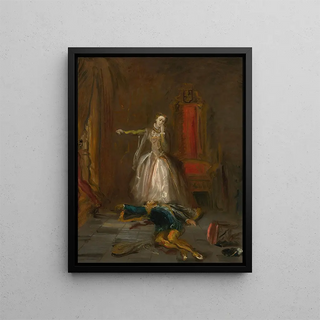Art print | Marie Stuart swearing to take revenge - Théodore Chassériau


View from behind

Frame (optional)
The artwork "Marie Stuart Swearing Revenge" by Théodore Chassériau is an iconic piece that immerses the viewer in a world filled with emotion and dramatic tension. This painting, which depicts the tragic figure of Marie Stuart, Queen of Scotland, is a true invitation to explore the intricacies of history and human passions. Chassériau, this master of Romanticism, manages to capture the intensity of this decisive moment, where the promise of revenge intertwines with feelings of despair and determination. By contemplating this piece, one immediately feels the weight of history and the anxiety of a queen facing her destiny.
Style and uniqueness of the work
Chassériau's style is distinguished by its ability to combine refined technique with poignant expressiveness. In "Marie Stuart Swearing Revenge," the rich and vibrant colors, as well as the play of shadows and light, create an atmosphere that is both dramatic and captivating. The faces of the characters are imbued with profound humanity, each expression telling a story. Chassériau uses flowing lines and dynamic compositions that direct the viewer's gaze toward Marie Stuart's decisive gesture, thus emphasizing the narrative tension of the scene. The psychological depth of the characters, combined with undeniable technical mastery, makes this work a true masterpiece of the 19th century, which continues to inspire and move.
The artist and his influence
Théodore Chassériau, born in 1819, is one of the most influential figures of French Romanticism. His work is characterized by heightened sensitivity and a constant search for beauty, often tinged with palpable melancholy. Influenced by great masters of painting such as Delacroix and Ingres, Chassériau develops a style that is uniquely his own, oscillating between classicism and Romanticism. His ability to treat historical and mythological themes with such emotional intensity made him an essential artist of his time. The impact of his work extends beyond his era, inspiring generations of art

Matte finish

View from behind

Frame (optional)
The artwork "Marie Stuart Swearing Revenge" by Théodore Chassériau is an iconic piece that immerses the viewer in a world filled with emotion and dramatic tension. This painting, which depicts the tragic figure of Marie Stuart, Queen of Scotland, is a true invitation to explore the intricacies of history and human passions. Chassériau, this master of Romanticism, manages to capture the intensity of this decisive moment, where the promise of revenge intertwines with feelings of despair and determination. By contemplating this piece, one immediately feels the weight of history and the anxiety of a queen facing her destiny.
Style and uniqueness of the work
Chassériau's style is distinguished by its ability to combine refined technique with poignant expressiveness. In "Marie Stuart Swearing Revenge," the rich and vibrant colors, as well as the play of shadows and light, create an atmosphere that is both dramatic and captivating. The faces of the characters are imbued with profound humanity, each expression telling a story. Chassériau uses flowing lines and dynamic compositions that direct the viewer's gaze toward Marie Stuart's decisive gesture, thus emphasizing the narrative tension of the scene. The psychological depth of the characters, combined with undeniable technical mastery, makes this work a true masterpiece of the 19th century, which continues to inspire and move.
The artist and his influence
Théodore Chassériau, born in 1819, is one of the most influential figures of French Romanticism. His work is characterized by heightened sensitivity and a constant search for beauty, often tinged with palpable melancholy. Influenced by great masters of painting such as Delacroix and Ingres, Chassériau develops a style that is uniquely his own, oscillating between classicism and Romanticism. His ability to treat historical and mythological themes with such emotional intensity made him an essential artist of his time. The impact of his work extends beyond his era, inspiring generations of art






